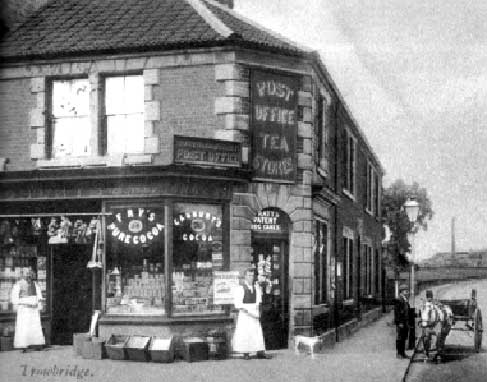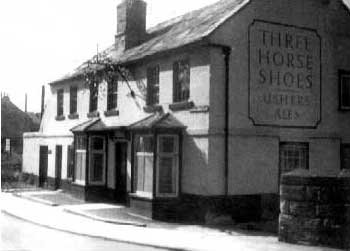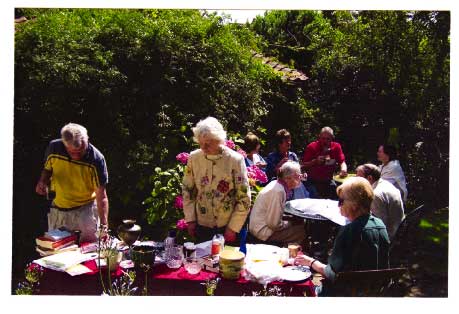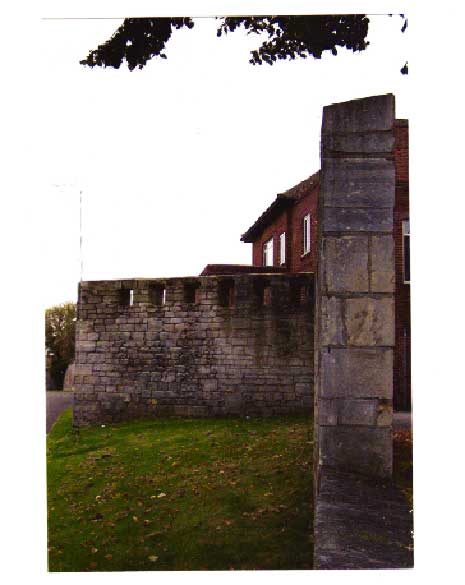Editorial Comment
After many years of toil on behalf of the Society, Kevin Hartley has retired from running our Newsletter. We owe him a big thank you for all that he has done and we know he would also like to include Margaret Howard in our thanks for her "behind the scenes" role. The Newsletter is now being produced by a team of four: John and Kay Austin, Glyn Bridges and Paul Lamb. We are tapping into Paul's vast experience of printing and publishing - from hot type to the latest digital technology. We are excited and not a little apprehensive at what we have taken over from Kevin. During this honeymoon period we have developed several ideas for the format and content but would be delighted to receive suggestions. A letter to the editors feature would be fun and an opportunity for you, the members, to express opinions and provide information on topics relating to Trowbridge and the surrounding villages and countryside. We hope you like the photographs. Please mention the Newsletter to any friends who might be encouraged to join the Society. You can contact us via the contact section on our website - http://www.trowbridgecivicsociety.org.uk
or click here.
From the Chairman
 At the AGM on 20th March we said farewell to retiring committee members Ann Beard, Daphne Peat and Barbara and John Woodford and again I thank them for all their hard work. We should then have had a talk from the Town Crier Trevor Heeks. Unfortunately Trevor was taken seriously ill (now thankfully recovered) shortly before. John Austin stepped in with a talk mischievously titled the Kray Twins. In the event it concerned John's ancestors, the Crays, including a Battle of Waterloo survivor and John Garrett (whose mother was a Cray), onetime Headmaster of Bristol Grammar School.
At the AGM on 20th March we said farewell to retiring committee members Ann Beard, Daphne Peat and Barbara and John Woodford and again I thank them for all their hard work. We should then have had a talk from the Town Crier Trevor Heeks. Unfortunately Trevor was taken seriously ill (now thankfully recovered) shortly before. John Austin stepped in with a talk mischievously titled the Kray Twins. In the event it concerned John's ancestors, the Crays, including a Battle of Waterloo survivor and John Garrett (whose mother was a Cray), onetime Headmaster of Bristol Grammar School.
The Woollen Trail walk on May 16th was well attended and we were enthralled with Ken Rogers' accounts of many aspects of the woollen industry. We had an equally informative walk around Beckington led by Mr R G Hoare on June 5th and this was also well attended. Although we had had some poor weather previously, on the day of the Coffee Morning and Bring and Buy Sale the weather was glorious. (see later). The trip to Tyntesfield on 29th August proved to be very popular indeed. Visits to grand houses are always fascinating and Tyntesfield is certainly no exception, particularly if you like Gothic architecture. The day was sunny but cool which made the walk from the coach to the house very pleasant. One aspect of the visit, which I think many visitors find interesting, is to see the National Trust volunteers busy recording artefacts in the house. Every item has to be photographed and catalogued, even the cracks and chips on pieces of china are recorded. Tyntesfield is well worth a second visit and hopefully those who were disappointed on this occasion will be first on the list.
Because of falling numbers the Emmanuel Church congregation is now meeting in a smaller hall, their main building and hall having been ‘mothballed’. Of even more concern is the news that the United Church congregation is negotiating to sell all their buildings to a developer. Both these churches have splendid interiors with fine organs and the United Church has handsome halls and offices. As the church and its halls are listed we can only hope that the new use is sympathetic in its treatment of this picturesque group of buildings.
Since I wrote about the Town Hall in the Annual Report there has been a new and, in my opinion, most regrettable development. The Heritage Lottery have refused the Town Council's application for the £40000 grant needed in order to put forward a bid for the main grant of £750 000 that would have ensured that the Town Council could go ahead with the Town Hall's refurbishment. Just what the County Council will do with the building is open to speculation but experience shows that they appear to have little or no interest in the county town, so the chances of them putting anything towards its upkeep I would think are nil. I understand that the likely reason the grant was refused was because a councillor who sits on all three authorities had written to the Heritage Lottery expressing disagreement with the scheme knowing full well that a grant is unlikely to be awarded if there is any local dissention. I will leave you to your own thoughts on the issue.
The County Highways department has still to provide a reason as to why Magnet is allowed to cut down the shrubbery beside their building, they have done it again this week (late August). I wonder what would happen if you or I took it into our heads to cut down any shrubs or small trees on any roadside verges that we decided we didn't want.
If you would like to complain (please do) the person to contact is the Highways Divisional Manager, Mr George Kemp, at the Melksham Depot.
Glyn Bridges
MORTIMER STREET - how it was
Miss Verena Dix was brought up in Mortimer Street, her parents moving there shortly before she was born in 1931. She has fascinating memories of the street and kindly shared them with me. She lived at number 15; it had two bedrooms upstairs with a front room, kitchen and scullery downstairs. The garden was very long and used solely for growing vegetables. The Dix family and their neighbours kept a bucket and spade propped by the back door and all tried to be first on the scene when a tradesman's horse dropped some ‘manure’. The house was on the right hand side going up from Cradle Bridge – almost opposite The Lamb Inn. In 1937 the Longfield housing estate was built with Longfield Road almost opposite the house. There was quite a battle with one resident (Lot Escott) who objected to having his house demolished and eventually he was offered the choice of any house he fancied on this new estate so that the council could proceed.
From Cradle Bridge and coming up on the right hand side the first building was the frequently flooded Three Horse Shoes public house. Children could be sent with a plain bottle to be filled with beer and the publican would seal it with a sticker – so their parents would know there had been no tippling. She also recalls that a horse and cart would be there to take them through when the floods were up. Next was Miss Duck's shop, which sold novelties and toys. Once a Mr Charlie Allsworth organized with others a big bonfire for 5th November, the fireworks were duly purchased from Miss Duck – but they all failed to ignite due to the dampness of the shop – also often flooded. What a disappointment! A rank of small houses was next including Mr Elliot, a plumber, who was the superintendant of St James's Sunday School. After the Dix household was Ben Cray (those members who attended the AGM will recall John Austin talking on the Cray family). Ben was very kind but eccentric, he always wore a trilby hat, ladies sandals and no socks. He worked at Hadens but also repaired guns and could often be heard at night shooting rats in his garden.  Mr and Mrs Trollope's shop came next. They sold groceries, cakes and newspapers. On Saturday afternoons they had a large wooden tray of delicious fancy cakes for sale, the Dix family would buy four and once home take it in turns to choose a cake each. This was on a very strict rota which Mrs Dix kept pinned on the pantry door. Woe betide you if you were slow in choosing – you could lose your turn! Mrs Trollope also sold what was known as ‘penny overweights’ a cone shaped bag with a long toffee or chocolate bar down the middle packed round with sweets and chocolates that had gone soft. (What we would consider these days to be past their sell by date). These were on sale on Wednesday lunch times and Verena would be sent to buy one each for her mother, herself and her cousin. Carrying on up the street were more houses until Bythesea Road and on the far corner one came to the shop of “Consul” Roberts. Verena has no idea where the nickname came from, he ran the shop and at the back his sister ran the post office. The shop was a general store but Mrs Dix would only buy its tinned goods as Mr Roberts would cut the butter into pats after serving paraffin with no hand washing in between. What would health and safety make of that today? Next came Case's the butchers, their slaughter house entrance being on Bythesea Road. Cases made sausages and faggots and, on Friday afternoons cooked chitterlings. During the war Verena recalls buying ‘fleck’. This was in a long strip, similar to suet, which her mother would render for the fat that was produced, which was then used for frying and occasionally for spreading on bread. As ‘fleck’ was not rationed there was a long queue when it was available. Beyond Cases was Harry Mortimer who repaired shoes – but not too swiftly as Verena recalls having to keep going to the shop to ask if the shoes were ready. Then came Pickard's, another general store, which was later run by the Browns who came from London and then by Charlie Crabbe. This store sold everything.
Mr and Mrs Trollope's shop came next. They sold groceries, cakes and newspapers. On Saturday afternoons they had a large wooden tray of delicious fancy cakes for sale, the Dix family would buy four and once home take it in turns to choose a cake each. This was on a very strict rota which Mrs Dix kept pinned on the pantry door. Woe betide you if you were slow in choosing – you could lose your turn! Mrs Trollope also sold what was known as ‘penny overweights’ a cone shaped bag with a long toffee or chocolate bar down the middle packed round with sweets and chocolates that had gone soft. (What we would consider these days to be past their sell by date). These were on sale on Wednesday lunch times and Verena would be sent to buy one each for her mother, herself and her cousin. Carrying on up the street were more houses until Bythesea Road and on the far corner one came to the shop of “Consul” Roberts. Verena has no idea where the nickname came from, he ran the shop and at the back his sister ran the post office. The shop was a general store but Mrs Dix would only buy its tinned goods as Mr Roberts would cut the butter into pats after serving paraffin with no hand washing in between. What would health and safety make of that today? Next came Case's the butchers, their slaughter house entrance being on Bythesea Road. Cases made sausages and faggots and, on Friday afternoons cooked chitterlings. During the war Verena recalls buying ‘fleck’. This was in a long strip, similar to suet, which her mother would render for the fat that was produced, which was then used for frying and occasionally for spreading on bread. As ‘fleck’ was not rationed there was a long queue when it was available. Beyond Cases was Harry Mortimer who repaired shoes – but not too swiftly as Verena recalls having to keep going to the shop to ask if the shoes were ready. Then came Pickard's, another general store, which was later run by the Browns who came from London and then by Charlie Crabbe. This store sold everything.
More ranks of houses led to Bullock's the greengrocer. During the war there was always a great queue when English tomatoes came in. The produce was displayed on the pavement in front of the shop. Over the railway bridge is the Greyhound pub. Verena knows little about the pubs as her father, who was employed by Ushers, had strong views about women going into them, and neither she nor her mother were allowed to enter one. She does say that she does not recall any drunken violence in the street &ndash just occasionally a wobbly man! This brings us to the Mortimer Street Co–op. A double fronted store, and very well patronised. Verena recalls that her mother's co-op number was 7611 and all the pink counterfoil ‘cheques’ would be put in a box by her mother, who always knew exactly what the ‘divvy’ would be. One year it was 1/6 (7.5p) for every pound spent. When the divvy was paid out, Verena was given a penny to spend and the family had ‘fat cake’ for tea! The next shop on our journey up the hill was Hampshire's who sold haberdashery and sweets.
This brings us to the Mortimer Street Co–op. A double fronted store, and very well patronised. Verena recalls that her mother's co-op number was 7611 and all the pink counterfoil ‘cheques’ would be put in a box by her mother, who always knew exactly what the ‘divvy’ would be. One year it was 1/6 (7.5p) for every pound spent. When the divvy was paid out, Verena was given a penny to spend and the family had ‘fat cake’ for tea! The next shop on our journey up the hill was Hampshire's who sold haberdashery and sweets.
Verena always bought four items for a penny (i.e. a farthing each) as she felt this was better value than blowing the whole penny on one item! Another two or three houses and we come to Moore's shop – yet another general store. Later this became Gowan's. The Moores were prominent in Wesley Road chapel. We now cross the road to the butcher's shop that looked down Mortimer Street, this belonged to Harry Cleveland whose brother kept another butcher's shop in Silver Street. He was always known as ‘Harry’ even to the children (quite rare in those days). His shop always had heaps of sawdust and his white apron was always spotless. He was a really nice man and parents knew they could send their children to the shop and he would always give them good meat.
We head back down the hill on the opposite side – almost no shops here. In the first house lived a dressmaker, Miss Griffin. Verena's family put plenty of work her way. An aunt could get a remnant of cloth for 6d (2.5p) and Miss Griffin could make it into a skirt for next to nothing. After the rank of houses is Havelock Street where Mrs Holloway had a shop and would always sell you something on a Sunday if you had run out. From there the street was residential until The Lamb and many members will recall the stone lamb that sat on the porch. Where is it now?
Finally we reach Longfield House, where Mrs Walker kept goats in the grounds. She was a well educated lady and formed a club for the local children – ‘The Goat Club’. About six or so attended, they were given goats milk to drink – not liked by Verena – they had talks and learned the difference between nannies and billies. Verena tells me it was the first time she had heard the word ‘agenda’ for Mrs Walker insisted on doing everything properly with quite formal meetings.
Mortimer Street was a very happy bustling place to live. There were 7 shops that sold food and others selling more fancy goods, so different from the supermarket economy of today. Having said that Mrs Dix and her sister always went to town on a Friday and shopped at Sainsbury's on Wicker Hill or Hamaton's in Silver Street.
Kay Austin
Planning Matters
Recently there have been a number of applications to create covered areas where customers can smoke. We have looked carefully at those for Listed Buildings and have been satisfied that they were at the rear and did not spoil the character or appearance of the properties. We were unhappy with the plans for Chicago Rock. They wanted to recess windows along Park Road to form an external terrace for smokers. We objected on the grounds that this could lead to public order disturbances. In the last Newsletter I said that we were pleased to note an increase in the number of applications to replace windows and doors in Listed Buildings with wooden ones. Even better this time I can report that WWDC has issued enforcement notices and those who have put in UPVC without permission have had to remove them and put back wooden structures.
We felt that the application received in March for the Wincanton site was not exactly exciting, although it was a definite improvement. If approved we hope that WWDC will negotiate some further improvements, as well as securing appropriate legal agreements with the developers. We were much happier with the proposals made by Barton Finch for the Ushers Bottling Plant site. At the consultation stage people generally liked the plans and wanted an early start. Notice was taken of comments made and these resulted in changes before formal application to WWDC. The development is to be called Brewery Quarter. An unpopular application to build a business park on Bradford Road was again rejected, but permission was given for a new skateboarding park in the Stallard Recreation Ground. Work was started for the conversion of 68 Fore Street into flats and so far it looks as if it will enhance that area. Trowbridge Football Club put in a very comprehensive application for pitches, (playing, practice and all weather), a stand, club house, children's soft play and car parking. Also a variety of flood alleviation works, a pavement and roadside drains along Woodmarsh. The Courts at Holt have had ponds drying up and they have permission to demolish and rebuild a wall, using a liner, to retain water. There have been two sets of plans for building near St Thomas's Church. Both have tried to make the housing units fit in with the character of the area. We have asked them to consider adding some chimney pots and pointed out that there are some ‘Trowbridge Roads’ street drain covers in the area and these are of considerable historic interest.
We were alarmed at plans to demolish the motor dealership property by the Town Bridge. However we were reassured that the front buildings would be retained. We wrote to say we had no objection provided extreme care was taken to retain the original retail building &ndash virtually unchanged since it was built in 1915 and a fine example of its type. We suggested that measures might be taken to stop the feral pigeon flock roosting there, thus reducing fouling in the area. Recently permission has been given for Arlington House, 72 Fore Street, to be converted from a single dwelling to four flats. All the usual safeguards relating to materials and methods appropriate to the conservation of a Listed Building must be submitted to WWDC for approval. Plans for 25 apartments on Broad Street have been withdrawn, presumably for modification. You may have seen the chimney pots on the houses on the Sleightholme garage site - something we recommended. I feel this development will blend well with the various houses in the area.
Margaret Howard
Trowbridge Football
Arguably the most significant sporting development ever in the town was last year's merger of Trowbridge Town and Trowbridge Town Youth Football Clubs. A team of coaches is coordinating about 20 teams playing in 3 leagues (Sport Italia Hellenic, Wiltshire Football and Trowbridge and District). Three adult teams will be supported by 17 teams giving opportunities to over 400 youngsters from 5 years and upwards. It should be noted that the club also includes four girls' teams. None of this would happen without the dedication and countless hours of hard work put in by the “Town” and “Youth” chairmen, John Fitchen and Andy Mackinder respectively,14 (!) managers, assistant managers, the rest of the committee and the unsung heroes that help out in many different ways. It is greatly to their credit that an exciting proposal for a new ground and sports complex, opposite the existing ground at Woodmarsh, North Bradley, has been submitted to the planning authorities for consideration this month (September).
Trowbridge Town was “officially” launched in 1880 and in 1892 joined the Bristol and District League (later to become the Western League) as a founder member. However it's very likely that a team representing Trowbridge was formed much earlier than 1880. In 1958 the team was promoted to the Southern League (reaching the 1st round of the FA Cup in 1963/4, losing 6-1 at home to Coventry City on 16 November 1963) and for three seasons enjoyed mixed fortunes in the Alliance Premier League. Those were the days of Alan Birchenall's player/managership and the former Chelsea, Leicester and England player's autobiography, “The Birch” is a good read. After a slump in fortune in the mid and late ‘80’s, epitomized by the fire which destroyed the old stand, heady days returned again under John Murphy's management, with the team reaching the semi final of the FA Vase competition in 1990/1. Although not really a soccer fan I considered the entrance money was worth it in those days just to marvel at Adie Harris's skill as an old fashioned winger and scorer of spectacular goals. Sadly the club folded after the 1997/8 season but freed from the slope of the Frome Road ground (previously the team played at Bythesea Road and the Flowershow Field, now called Stallard Recreation Ground) it reformed in time to start the next season at Woodmarsh in the Wiltshire League. In 2003/4 the “Town” won the Wiltshire League Championship, beating Corsham on penalties on a memorable night in Chippenham. Last season it finished runners up in the Sport Italia Hellenic League, Division 1, West.
Trowbridge Town Youth is working with other organizations, including the Cricket Club, to provide high quality sport in the local community. It has been recognised as an FA Charter Standard Club determined to provide the best environment for the development of young footballers. Trowbridge Town Football Club is providing a wonderful sporting experience for young people, with its ethos of sportsmanship and teamwork. The national sell off of sports fields is a disgrace and our town football club needs all the support it can get and surely has our best wishes for a successful future.
John Austin
The Douglas Male Story (conclusion)
Rutland Garage in Bradley Road (where the writer had worked since leaving school) was demolished to make way for expansion. A brand new showroom and office complex was built with flats on the upper floors, one of which was eventually to be my home after getting married – in return for running the out of hours breakdown service. Eventually the firm was taken over by Baxter and Stillman, who expanded the site towards Frome Road. All the earth that was taken from the site of what was to become the new filling station, was taken to Trowbridge Town Football ground for use as raised spectator banking. Everybody joined in with this, Mr Stillman himself drove the earth scraper and I drove the tipper lorry. After only a short time the firm was taken over again, this time by Ramsey Motors.
Some time later my wife and I were allocated a council house in College Road. In 1965 I heard that there was a vacancy for a mechanic at the Post Office vehicle workshop in Bythesea Road. I was successful in obtaining this position thus becoming one of “God's Poor Orphans”! After a year the works moved to a brand new workshop at the rear of the main post office overlooking The Park. I was there for the remaining 38 year of my working life. Occasionally I would be transferred to other workshops, namely Axminster (1 year), Bath, Bristol, Glastonbury, Hawthorn, Marlborough and Swindon.
Thus ended a very enjoyable period of my life, I still remain active, joining in an organized walk at least once a week, gardening and DIY and pursuing my hobbies.
Douglas Male
TROWBRIDGE SHOPS in the 1890's
| The latest in the series of the “Yellow Books” published by the Friends of Trowbridge Museum, appeared earlier this year. Written by Society member Roger Newman it is essentially a letter – some letter. In 1958 Nelson Arthur Dowling, a native of Trowbridge, but then living near Weymouth, wrote to the Wiltshire Times and described an imaginery perambulation of the town centre with quite uncanny recall from about 60 years before of the shops, offices, manufacturies, householders etc. The second part of the book repeats the letter but corrected and annotated with snippets from Roger's enormous data bank of the commercial history of the town. The work is illustrated with photographs, a map and bill heads. At one point Roger comments that Darracott's jewellery business was taken over by Frank Hilser in 1909. My late aunt, and one time life member, Bernice was forbidden by her father to develop a relationship with Leo Hilser on the dubious grounds of his being Jewish and a Catholic. I learned from this most enjoyable read that he was descended from a Bavarian cuckoo clock maker. It's not difficult to guess another of my grandfather's prejudices. The previously published “Yellow Books”, many of which are available in the Museum shop are as follows:
|
Coffee Morning and Bring and Buy Sale - 7th July
 Glyn and Ruth Bridges were our hosts for this event, their garden was looking stunning and
amazingly for this summer, the sun was blazing. About 30 members enjoyed the sunshine and Ruth's home made biscuits (absolutely delicious). The Bring and Buy table did well and we banked £48.09. At times members were forced to take refuge in the shade which was no problem as the garden has delightful shaded areas as well as a stream and many garden ‘rooms’. It was interesting to see the base of the foundry chimney dating back to 1818 (when the house belonged to an ironfounder and millwright) and the old foundry wall close to the bridge across the stream.
Glyn and Ruth Bridges were our hosts for this event, their garden was looking stunning and
amazingly for this summer, the sun was blazing. About 30 members enjoyed the sunshine and Ruth's home made biscuits (absolutely delicious). The Bring and Buy table did well and we banked £48.09. At times members were forced to take refuge in the shade which was no problem as the garden has delightful shaded areas as well as a stream and many garden ‘rooms’. It was interesting to see the base of the foundry chimney dating back to 1818 (when the house belonged to an ironfounder and millwright) and the old foundry wall close to the bridge across the stream.
Thank you Glyn and Ruth and congratulations on winning second prize in the town's back garden completion.
Sleightholmes Site Development
 It is always sad to see an old established family firm close down and Sleightholmes was one of the most recent. One positive thing about this is that the site was developed fairly quickly, unlike many other still vacant areas that continue to blight the centre of Trowbridge. The developers have made quite a successful attempt to reflect the surrounding late 19th century terraces. The new homes are mostly of brick with stone window and door surrounds while a few are of render with similar stone dressings, no doubt in an effort to provide some variation to the street scene.
It is always sad to see an old established family firm close down and Sleightholmes was one of the most recent. One positive thing about this is that the site was developed fairly quickly, unlike many other still vacant areas that continue to blight the centre of Trowbridge. The developers have made quite a successful attempt to reflect the surrounding late 19th century terraces. The new homes are mostly of brick with stone window and door surrounds while a few are of render with similar stone dressings, no doubt in an effort to provide some variation to the street scene.
Another plus as far as I am concerned is that at the end of each block is a chimney stack with a single pot. These may be only tokens but they do much to relieve the monotony of the roofline. Have a look at the Duke Street development and you will see what I mean. The whole site is called Sleightholme Court which to the relative newcomer to Trowbridge would seem to be a very appropriate name. It is a pity that the original use of the site as the Trowbridge Barracks could not have been reflected in some of the naming at least. One good thing is that you can now see clearly the row of six gun embrasures in the remaining section of the north west bastion wall.
Glyn Bridges